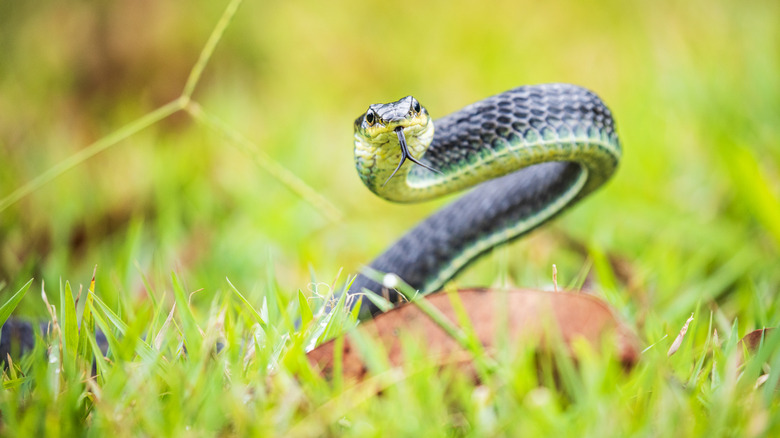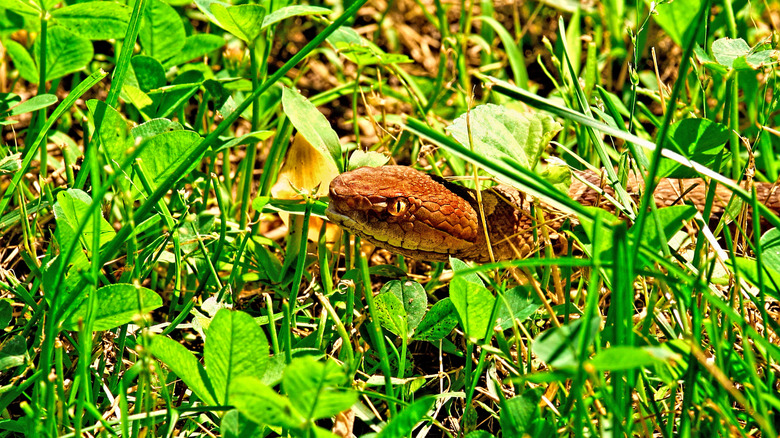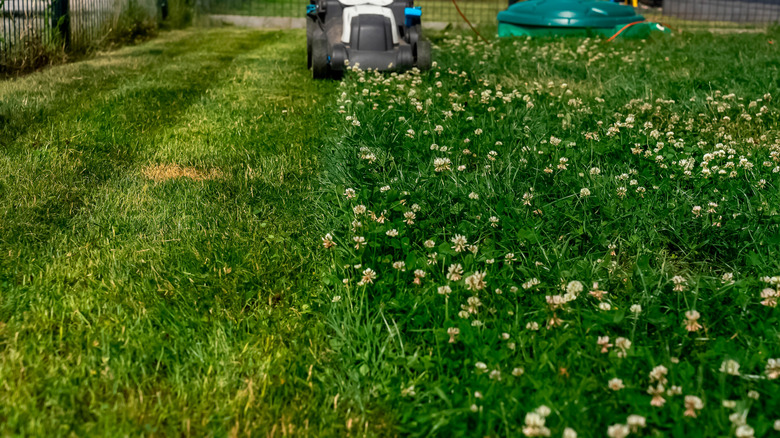Got Kids And Pets? Know This Before You Plant This Snake-Attracting Ground Cover
Maintaining a lawn requires an immense amount of work to keep it looking lush and perfectly trimmed. If you're a homeowner, you've probably wondered if there are any eco-friendly grass alternatives for your lawn that are just as attractive but easier to maintain. One such alternative, clover (Trifolium repens), has gained popularity thanks to its similar bright green vibes, lovely flowers, and low-maintenance needs. But before you scrap your lawn, there are some facts you should know about having a clover lawn, especially if you have kids or pets: it can attract snakes.
Along with other ground cover options like creeping thyme, mint, moss, or ornamental grasses, clover is often grown as an alternative to traditional grass. It grows well in USDA Hardiness zones 3 through 10 and resiliently handles cold temperatures. Clover loves moist but well-drained soil and prefers full sun, but it can tolerate partial shade to some degree. This ground cover became popular because it uses less water than a lawn, requires less mowing, helps keep its own soil balanced, has a high resistance to pests and diseases, and even attracts helpful pollinators like butterflies and bees. With its lush look to boot, clover couldn't help but be appealing to homeowners.
But clover still comes at a price, so to speak. The fact that this gorgeous lawn alternative attracts snakes and other pests should be enough to make parents and pet owners think twice before creating a clover lawn in the backyard. Clover is dense enough for snakes to hide in, and will draw in other animals for snakes to feed on, giving them a reason to stay put in your yard.
Why are snakes attracted to clover?
Snakes are not directly attracted to clover itself, just everything it affords them: shelter, water, food, and lots of space. Clover grows anywhere from four inches up to one foot tall, and is dense enough for snakes to hide in, giving them plenty of cover for relaxation, hiding, and hunting. The groundcover also lends a lot of cool and moist areas along with sunny spots for the reptile's temperature regulation.
Clover also offers snakes a convenient feeding ground. The plant attracts a variety of food sources, from bugs to mice, especially when it grows long. Fortunately for them, this ensures snakes have an appealing and well-rounded diet available pretty much all of the time, without requiring the snakes to do much active hunting to get the food.
The type of snakes you will end up seeing in clover lawns depends greatly on where you live. However, the most common types are garden snakes and garter snakes. There's no need to worry, however, because these species are not venomous. More dangerous and venomous species — such as copperheads — are less likely to pop up in your clover, as they typically prefer wooded, brushy areas. That's no guarantee, however, as any snake can still be attracted to places with food sources and cover.
How to create a safer clover lawn
If you're still determined to grow a clover lawn, fret not, as it is not a completely untenable idea. While clover lawns do present a unique set of challenges, there are a few easy steps you can take to mitigate the risks listed above and lessen the chance of them becoming big issues. Firstly, you should choose microclover. Microclover is a better choice vs. standard white clover, since it is shorter and produces fewer flowers. Alternatively, consider blending clover with your existing turf grass. You could even do clover in the front yard for looks and low maintenance, then plant traditional grass in the backyard so kids and pets will have a safer place to play.
If you still want a full clover lawn, however, we recommend mowing frequently. Keep this lawn short, if not shorter than traditional lawn, so that snakes have nowhere to comfortably hide. Along the same lines, keep the areas right next to your home super tidy. Regularly remove leaf and brush piles, and clear up any other debris that looks like it could house snakes. Also consider sealing up any holes in your home's exterior, be it gaps between brick, worn away dirt under patio cement, or even holes in a fence next to a yard with lush grass. Next, educate yourself on the common snake species in your area so you can keep an eye out for them, and teach kids how to recognize snakes and leave them alone. With these tips, you can mitigate the dangerous elements of a clover lawn and enjoy its beauty, too.


